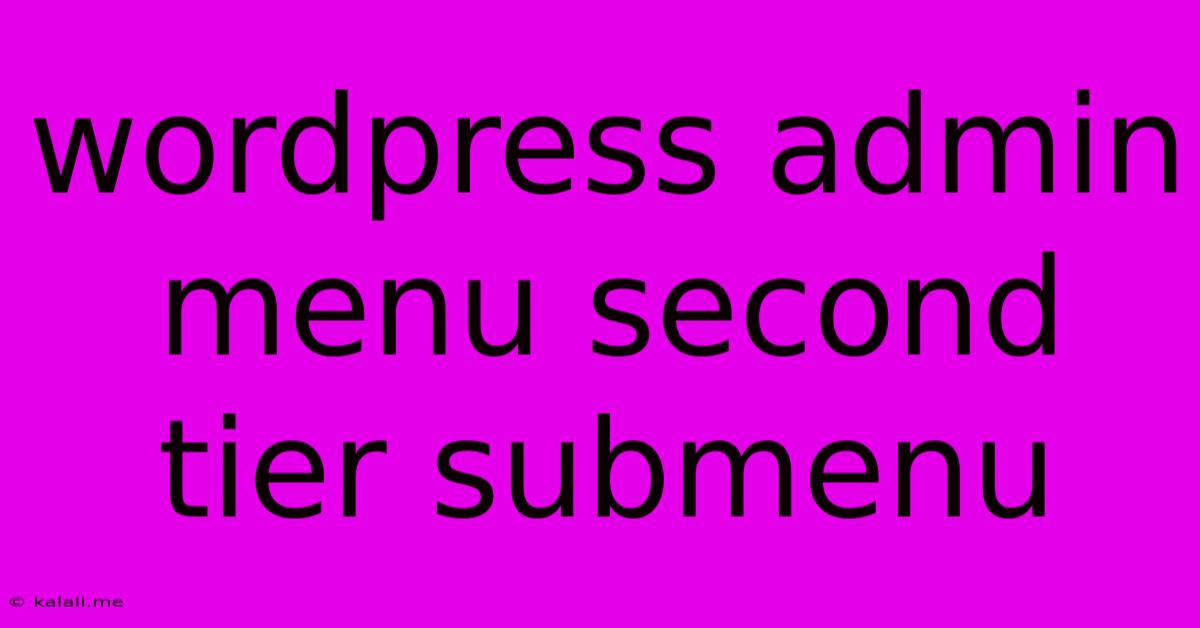Wordpress Admin Menu Second Tier Submenu
Kalali
May 25, 2025 · 3 min read

Table of Contents
Mastering WordPress Admin Menu: Creating Second-Tier Submenus
WordPress offers a flexible admin interface, but sometimes the default menu structure needs a little extra organization. This article will guide you through the process of creating second-tier submenus in your WordPress admin panel, improving navigation and user experience for both yourself and other administrators. We'll cover the different methods, from using plugins to implementing custom code, ensuring you choose the best approach for your needs and technical skills.
Why Use Second-Tier Submenus?
A cluttered WordPress admin menu can be overwhelming, especially for websites with numerous plugins and custom post types. Second-tier submenus offer a solution by:
- Improved Organization: Grouping related items under a parent menu provides a more logical and intuitive structure.
- Enhanced User Experience: A cleaner, more organized menu improves the admin experience, reducing frustration and increasing efficiency.
- Better Navigation: Quickly locating specific settings becomes easier, saving time and reducing errors.
- Scalability: As your website grows and you add more features, a well-structured menu remains manageable.
Methods for Creating Second-Tier Submenus
There are two primary ways to achieve this: using a plugin or adding custom code to your theme's functions.php file. Let's explore both:
1. Using a Plugin: The Easier Route
Several plugins are designed specifically for managing and customizing the WordPress admin menu. These provide a user-friendly interface for creating submenus without needing to write code. Popular options often include features like drag-and-drop menu management, conditional menu visibility, and role-based access control. Choosing a reputable plugin ensures compatibility and minimizes potential conflicts with other plugins or your theme.
Benefits of using a plugin:
- Ease of use: No coding knowledge required.
- Visual interface: Drag-and-drop functionality makes menu management simple.
- Additional features: Plugins often offer extra features beyond basic submenu creation.
- Reduced risk of errors: Well-tested plugins minimize the chance of breaking your website.
2. Custom Code: For Advanced Users
For users comfortable with PHP code, modifying your theme's functions.php file offers a powerful and flexible approach. This method allows for precise control over the menu structure and provides the ability to integrate submenus with custom functionality. However, it’s crucial to back up your website before making any code changes.
Here's a basic example of how to add a second-tier submenu using a add_submenu_page() function:
function add_my_submenu_page() {
add_menu_page( 'My Main Menu', 'My Main Menu', 'manage_options', 'my-main-menu', 'my_main_menu_page' );
add_submenu_page( 'my-main-menu', 'Submenu Item 1', 'Submenu Item 1', 'manage_options', 'my-submenu-item-1', 'my_submenu_item_1_page' );
add_submenu_page( 'my-main-menu', 'Submenu Item 2', 'Submenu Item 2', 'manage_options', 'my-submenu-item-2', 'my_submenu_item_2_page' );
}
add_action( 'admin_menu', 'add_my_submenu_page' );
function my_main_menu_page() {
//Content for main menu page
}
function my_submenu_item_1_page() {
//Content for submenu item 1
}
function my_submenu_item_2_page() {
//Content for submenu item 2
}
Remember to replace placeholder text and slugs with your own. This code adds a main menu item "My Main Menu" with two submenu items. Each function (my_main_menu_page, etc.) defines the content of each page.
Important Considerations:
- Capability: The
'manage_options'capability restricts access to users with administrator privileges. Adjust this based on your requirements. - Menu Position: The order of
add_submenu_page()calls determines the order in the menu. - Testing: Thoroughly test your code after implementation to ensure functionality and avoid conflicts.
Choosing the Right Method
The best method depends on your comfort level with coding and the complexity of your needs. Plugins offer ease of use and a lower risk of errors, making them ideal for beginners. Custom code provides greater flexibility and control, but requires coding expertise and careful testing. Regardless of your choice, a well-organized WordPress admin menu significantly enhances the overall user experience and administrative efficiency.
Latest Posts
Latest Posts
-
R C Cola And A Moon Pie
Jul 04, 2025
-
If I Was 18 What Year Would I Be Born
Jul 04, 2025
-
One And Three Hundred Twenty Four Thousandths
Jul 04, 2025
-
How Much Is 2 Pounds Of Cream Cheese
Jul 04, 2025
-
How Do You Pronounce M I C H A L
Jul 04, 2025
Related Post
Thank you for visiting our website which covers about Wordpress Admin Menu Second Tier Submenu . We hope the information provided has been useful to you. Feel free to contact us if you have any questions or need further assistance. See you next time and don't miss to bookmark.